Ooops, this should have posted the 25th…all references in the post though it posted today are for the 25th. The meltdown was the 24th, not my duty night.
Note: I think that I have pretty much recovered from last night’s mini-meltdown, though tired have has a good day working some stuff that is pretty cool that could be a positive thing for Navy and VA Chaplains. I think success does help mitigate some of the effects of a meltdown. If today had been crappy and I hadn’t had a good talk with Elmer the Shrink it might have continued. Now with some sleep I could be cooking with gas even though my house is all electric.
On to the Post:
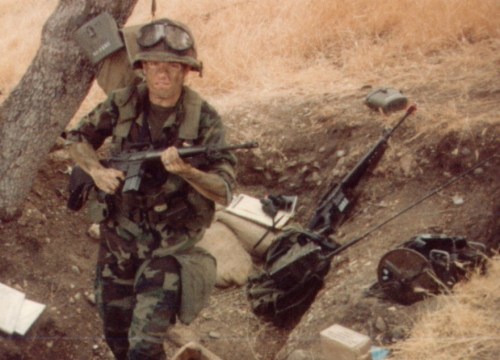 Enlisted in National Guard 1982
Enlisted in National Guard 1982
“So we’re all dogfaces, we’re all very, very different, but there is one thing that we all have in common: we were all stupid enough to enlist in the Army. We’re mutants. There’s something wrong with us, something very, very wrong with us. Something seriously wrong with us – we’re soldiers. But we’re American soldiers! We’ve been kicking ass for 200 years!” Bill Murray as John Winger in “Stripes” 1981
Well sports fans I am at the hospital tonight celebrating 28 years of service in the military. It really doesn’t seem like any more than 27 ½ but who’s counting right? And when I look back at the Army I joined I am reminded of Stripes.
I think that I have pretty much recovered from last night’s mini-meltdown, though tired have has a good day working some stuff that is pretty cool that could be a positive thing for Navy and VA Chaplains. I think success does help mitigate some of the effects of a meltdown. If today had been crappy and I hadn’t had a good talk with Elmer the Shrink it might have continued. Now with some sleep I could be cooking with gas even though my house is all electric.
So 28 years ago today I went down and signed my name on the dotted line. It was August 25th 1981 two months after the release of the movie Stripes and two months before I saw it with Judy at the $1 movie theater. On that end of summer day I went down and signed my contract with the Army ROTC program at UCLA with the Chief Lord of Discipline himself, the Captain Bruce Lawson swearing me in. He had just finished PT and though still in his PT clothes administered the Oath of Enlistment. It was not much on ceremony but it was a start. In fact most of my promotions in either the Army of the Navy have not come with much fanfare and I’m actually pretty okay with that so long as I get paid and get to do what I love doing which is being a Priest and getting to serve now as a Navy Chaplain. So I followed with a trip down to the National Guard Armory on Victory Blvd in Van Nuys to enlist in the National Guard. Since I was not a scholarship student I was allowed to simultaneously enter the Guard. So the 25th was kind of like a double header for me, I did the oath for the Guard later in the afternoon. It’s like Tommy Lasorda once said: “I love doubleheaders. That way I get to keep my uniform on longer.”
So I went in to Headquarters and Headquarters Battery and met the Company Commander, Captain J.J. Kramer, now a retired Colonel I believe and Major Charles Armagost, the Full Time Unit Administrator and Adjutant. Wearing his green fatigues the good Major administered the Oath for the California National Guard, which differed from the Federal Oath in that it also included words about obeying the Governor of the State and the Laws of California etc…Following that I was walked down to the supply room where a rather rotund Sergeant began issuing me uniforms and field gear. I got my first gift of US Military designer clothing and was told to report the Thursday after Labor Day for a “Battery Dark Night.” So began my rather auspicious career.
I remember being in uniform in those early days without a single ribbon or medal to my name. I’d look around and see all the guys who had served in Vietnam and some in Korea as well with all kinds of ribbons, medals, unit citations and qualification badges. I would look at them and once I remarked to Judy that I wish that I would have a lot someday. She accused me of whining, something that I feel is a mischaracterization of my attitude about not having anything and something that now with a full chest of ribbons, medals and qualification pins that she is not hesitant to remind me of and tell others about.
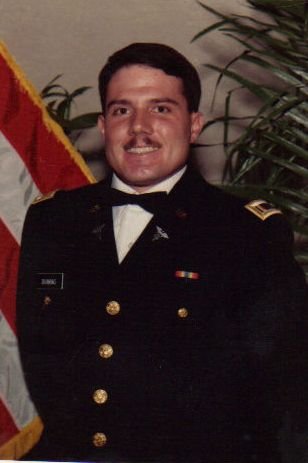 Look Mom One Ribbon
Look Mom One Ribbon
So what has transpired in 28 years? Here are some of the highlights and a few lowlights of the of this adventure.
In 1981 it all began and things happened fast, within two weeks of enlisting I was driving an M-151A1 Jeep to Ft Irwin CA as part of battalion advance party and then spending the weekend learning to call in artillery fire. After going through hell and being destroyed and rebuilt by SFC Harry Ball, Drill Sergeant US Army like Richard Gere was in An Officer and a Gentleman I somehow got commissioned in part due to the forbearance of Major Lawson, the former Captain Lawson who has sworn me in. Judy asks if I had my own “Puget Sound Deb” when she sees the movie with me that winter. However just prior to getting commissioned during my last annual training period at Camp Roberts I led team of Ersatz East German Kommando’s on raids against battalion rear area as the opposing forces. I was almost run over in may M-151A1 by an M-548 Ammo Carrier during a strafing run coming down hills firing blanks from machine guns like the Rat Patrol and dropping Smoke and CS grenades in the vehicle’s path. Later we captured the battery Operations Center during a firing mission. None of this made them happy but the Forward Observers and I had a blast.
After I got commissioned I attended the Medical Department Officer Basic Course at Ft Sam Houston TX and suffered for Jesus for 9 weeks in the Riverwalk Marriott hotel in downtown San Antonio. After this I spent 11 glorious weeks at Ft Knox Kentucky which by the way is in a “dry county” or at least it was back then going through a 6 week course after being bumped by Saudi Arabian exchange officers.
 Company Commander
Company Commander
From January 1984 through late December 1986 we were stationed with the 557th Medical Company Neubrucke and later Wiesbaden. Was a platoon leader and became company XO when our XO checked into a psych ward before Winter REFORGER. While in the field was promoted but o one realized that fact until we came out of the field in mid- February. In a late night hastily arranged ceremony which I had to drag Judy in from bed to see I was promoted and got my first real medal. In September I became a “relief pitcher” Company Commander when my new CO got fired. I was told “Lieutenant; clean up that Company.” After 7 months, and having to adjudicate close to 50 Article 15’s, and kicking a bunch of drug users out of the Army I was relieved by a Captain and I had my first and last Change of Command ceremony. Became a personnel officer at our group, pissed off the boss and had a miserable last couple months in Germany. However I completed my first row of ribbons made some really good lifelong German friends and learned to drive really fast and really good and developed a fine appreciation of good beer.
In 1987 I attended the Military Personnel Officer Course at Ft Benjamin Harrison which is in Indianapolis and continued on to Fort Sam Houston where I was assigned as the Adjutant for the Academy Brigade, Academy of Health Sciences. I got promoted right after I got there and since Judy had not arrived I had the world’s best platoon sergeant, SFC Cynthia Carter help pin on my new Captain bars. Judy was quite happy that Cindy got to do this as she really liked her. My Brigade Commander wondered what was up with that, but it was an honor to have her do the pinning. While there I worked on AIDS/HIV personnel policy and became “CINC AIDS” at the Academy. While there I collected my second Army Achievement Medal and an Army Commendation Medal.
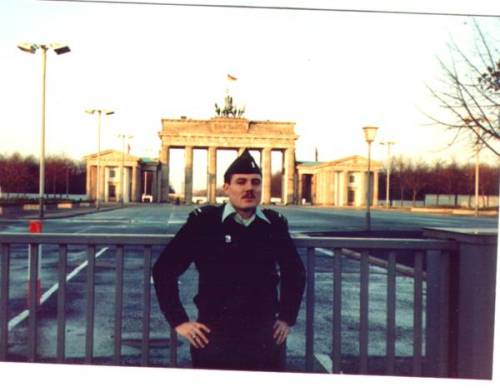 Berlin Wall 1986
Berlin Wall 1986
In 1988 I left Active Army to attend Seminary and was appointed as an Armor officer in Texas Army National Guard. I was told by my boss LTC Jim Wigger that I was moving from the “frying pan into the fire as the chaplains were a cutthroat bunch” and that the “Medical Department was not even in the same league as the Chaplains.” When the Division Chaplain found out that a seminarian was getting ready to drive tanks he pitched a fit and had me enter the Chaplain Candidate program. In seminary I attended the Chaplain Officer Basic Course at Fort Monmouth NJ. As Deputy Course leader and Company “First Sergeant” pissed off lots of chaplains and seminarians. Thankfully I was backed up by LTC Rich Whaley who saved my ass for the first time and not the last time. I met my friend Fr Jim Bowman who kept me from doing anything really stupid. In 1992 I graduated from seminary was ordained and become a chaplain and assigned to 111th Engineer Battalion in Abilene. That year I got thrown out of the Chaplain Officer Advanced Course when school changed a policy on Chaplain Candidates awaiting final approval to be chaplains to enter course. After Billy Martin style tantrum Rich Whaley saves my ass a second time.
In 1993 I went back to Chaplain Officer Advanced Course, made amends and did the appropriate penance. Meet up with Fr Jim Bowman again. In the fall of 1994 finished the final phase of the Chaplain Officer Advance Course. Happiness is Ft Monmouth in your rear view mirror. In the summer of 1984 I viewed the O.J. Chase live on miniature TV in M-577 Command Track with Lakers playoff game in split screen while at Fort Hood.
In January 1995 I moved to Huntington WV to take a job as a contract ER Chaplain. I transferred from one former Confederate Unit to another going from the Texas to the Virginia Army National Guard. In December I was promoted to Major and transferred to the Army Reserve and got rid of the 410 mile one way trip for a drill.
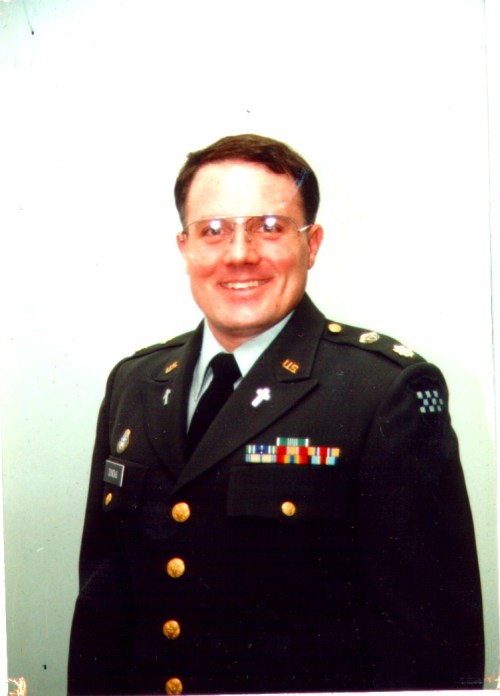 New Major December 1995
New Major December 1995
In July of 1996 I got mobilized and sent to Germany to support Bosnia mission, lose job. While in Germany get to do a lot of cool stuff, got a bunch of medals and though the Chaplains there wanted me to be brought on regular active duty get told I am too senior to transfer to Regular Army. I actually think that the guy who made the decision remembered me from Chaplain School and did not want someone like me in “his” Chaplain Corps. Upon my return from Bosnia support the Reserves assigned to Ft Indiantown Gap PA as Installation Command Chaplain where in September 1998 I got to close down help close down the Federal side of things and transfer chapel and congregation to National Guard care. In October I returned to the reserves like a journeyman ball-player being sent back to AAA from the Majors. In December the Navy offered me a deal to play “in the show” on active duty and I took it, went from being an Army Reserve Major to Navy Lieutenant. My friend Father Fred Elkin was my first detailer and offered me a choice of East Coast or West Coast Marines when I asked for a ship. We now serve together and get a good laugh about that now. It did turn out to be a good thing for me. One of the cool things about my time in the Navy has been since I have blown myself up enough in the Army and seen others do likewise that I know where the career “land mines” are and how not to step on them. This has been a great benefit to me. It was like changing from one league to another in the middle of a baseball season. The old stats don’t count for or against you when you start playing in the new league.
After Navy Chaplain School I was assigned to the 2nd Marine Division at Camp LeJuene NC. From then on my life has been going non-stop. I was chaplain for 4 different battalions in the Division where Father John Kaul used me as a “relief pitcher” in situations where chaplains had either been fired for doing illegal or immoral things or replacing people who had to move on short notice orders. Did CAX at 29 Palms on multiple occasions and did a deployment to the Far East, Okinawa, Japan and Korea. Collected more medals got my “old” version Fleet Marine Force Qualification. I was assigned to HQ BN 2nd MARDIV. 9-11 -01 attack happened. A couple of months later I reported to USS HUE CITY CG-66 in Mayport.
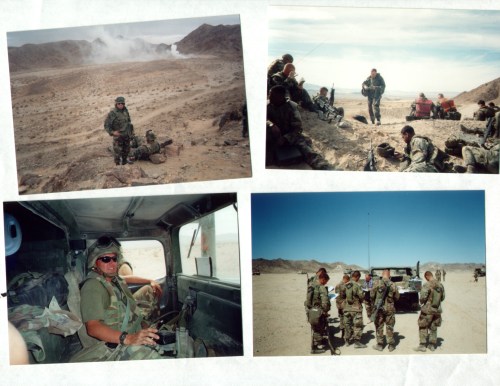 Dundas of the Desert 29 Palms 2000-2001
Dundas of the Desert 29 Palms 2000-2001
Not long after reporting went on the final work up exercises prior to deployment, deployed to the Horn of Africa, Northern Arabian Gulf, Gulf of Oman and Mediterranean. Was an advisor for a boarding team in Northern Arabian Gulf and made 75 boardings of detained smugglers. We almost got to see the Indians and Pakistanis get in a nuclear war, that was a bit sporty and we supported air operations in Afghanistan. After a period in the yards during following deployment as well as work with the great Marines who served in the Battle of Hue City I checked off the ship in October 2003, again collecting more medals and ribbons.
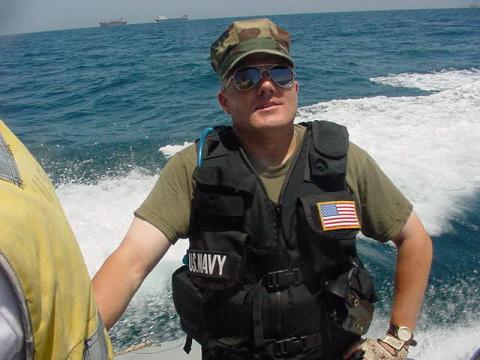 Boarding Party 2002
Boarding Party 2002
I went to Norfolk where I was assigned to the Marine Corps Security Force Battalion and my Commanding Officers, Colonel Mike Paulovich and Colonel Donald Rogers sent me about the world to care for our Marines. Over that time I probably averaged 2 trips a month out of the area, many overseas to Japan, Hawaii, Spain, France, the United Kingdom and Bahrain, others to places far and wide in the Continental United States. Colonel Paulovich and I probably worked more closely together than any commander that I have ever worked with and we went through many difficult times in that assignment. We are still friends to this day. One of the cool things is the people that we work with. I was promoted to Lieutenant Commander in April 2006. This meant that I had spent almost 16 years of my career wearing Captain or Lieutenant bars. I again collected more ribbons and medals for the time with the Marines and was one of the first Navy Officers to get the Fleet Marine Force Officer Qualification pin while completing Marine Command and Staff College.
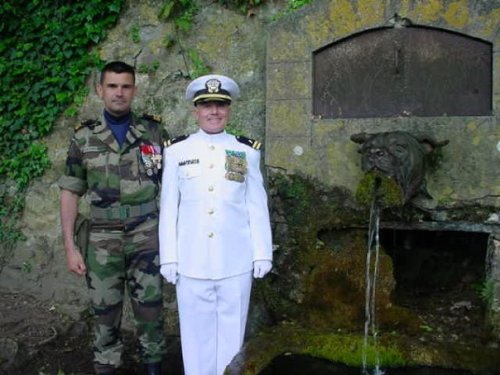 Belleau Wood France 2004
Belleau Wood France 2004
I then went to Navy EOD Group Two in Little Creek where I was the first chaplain assigned to EOD. While there I got to go to Jordan to the Jordanian Army/UN Peace Operations Training Center and to Sicily. I was snatched up to go to Iraq in July 2007 and served the most meaningful operational deployment of my career serving our Marine, Army, Navy, Air Force and Department of Justice and Homeland Security advisors to the Iraqi Army, Police and Border Forces in Al Anbar Province. I came back from Iraq with a great case of PTSD, a gift that keeps on giving. I checked out of EOD in September 2007 again with more medals and ribbons to my current assignment at Naval Medical Center Portsmouth where I get to do what I am passionate about as a Priest and Navy Chaplain serving in a teaching hospital.
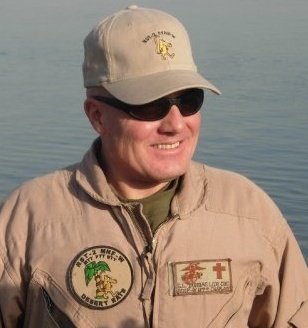 Iraq 2008
Iraq 2008
Looking back it has been a long and strange trip and it is still an ongoing journey. People ask me how I keep going even with the PTSD and it’s like Tommy Lasorda says “Guys ask me, don’t I get burned out? How can you get burned out doing something you love? I ask you, have you ever got tired of kissing a pretty girl?” Speaking of which now that I am on the way home after 31 or so hours at work I probably need to do with Judy when I see her.
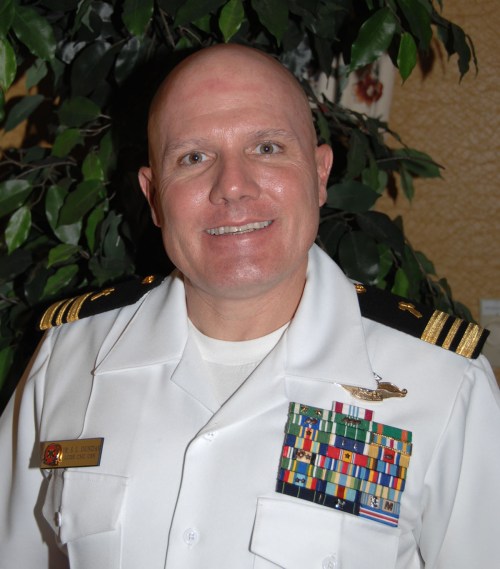 July 2008, Grand Admiral of the Ottoman Navy?
July 2008, Grand Admiral of the Ottoman Navy?
Peace, Steve+



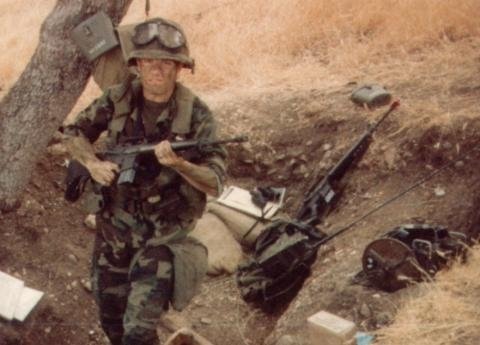
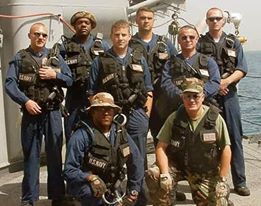








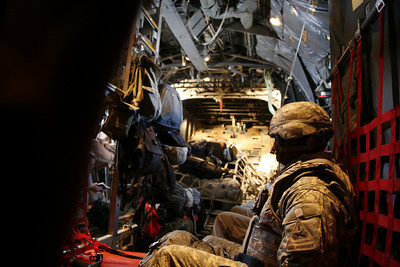

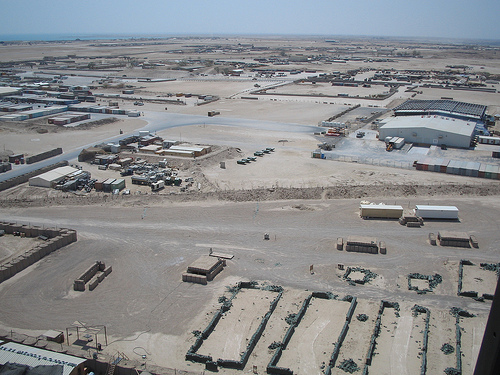 TQ: The Chow Hall is on the Right
TQ: The Chow Hall is on the Right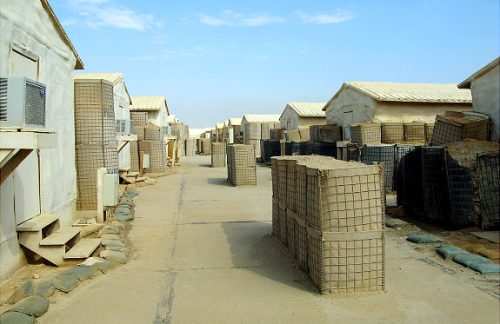 Southwest Asia Huts or SWA Huts at TQ I stayed in one of these at the end of my tour
Southwest Asia Huts or SWA Huts at TQ I stayed in one of these at the end of my tour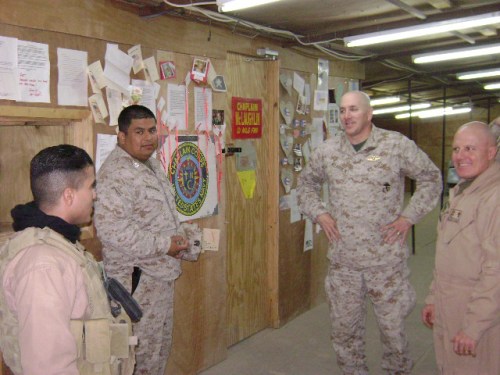 A Great Team: Nelson, Jose, Pat and Me…Pat and Jose helped us tremendously
A Great Team: Nelson, Jose, Pat and Me…Pat and Jose helped us tremendously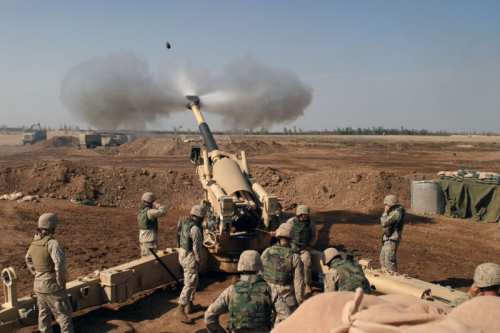 USMC 155mm Howitzer firing on Insurgents at Fallujah in 2007
USMC 155mm Howitzer firing on Insurgents at Fallujah in 2007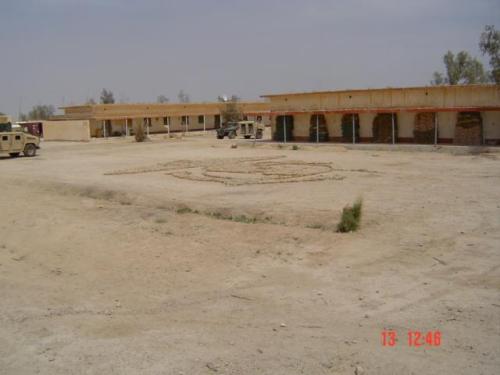 Ramadan Inn
Ramadan Inn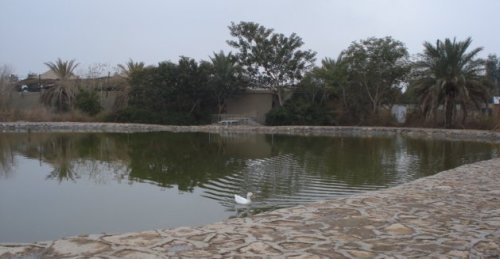 Pond at Fallujah
Pond at Fallujah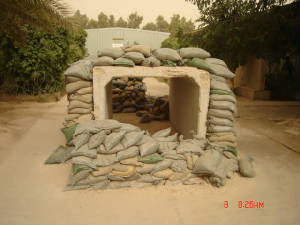 Bunkers to Protect Against Indirect Fire at Camp Fallujah
Bunkers to Protect Against Indirect Fire at Camp Fallujah Monument in the Traffic Circle at Camp Fallujah
Monument in the Traffic Circle at Camp Fallujah Enlisted in National Guard 1982
Enlisted in National Guard 1982 Look Mom One Ribbon
Look Mom One Ribbon Company Commander
Company Commander Berlin Wall 1986
Berlin Wall 1986 New Major December 1995
New Major December 1995 Dundas of the Desert 29 Palms 2000-2001
Dundas of the Desert 29 Palms 2000-2001 Boarding Party 2002
Boarding Party 2002 Belleau Wood France 2004
Belleau Wood France 2004 Iraq 2008
Iraq 2008 July 2008, Grand Admiral of the Ottoman Navy?
July 2008, Grand Admiral of the Ottoman Navy?